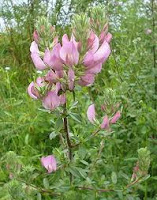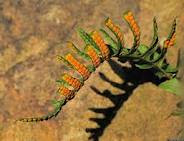The African tulip tree is a fast growing evergreen which can reach heights of 35 metres. It is known as the fountain tree, Uganda Flame tree, the Nandi or Nile Flame tree, and the Squirt tree, among other names. It is indigenous to tropical Africa , although it is grown ornamentally in many countries with tropical climates around the world.
It is the only member of the genus Spathodea but is a member of the Bignoniaceae family which makes it a relative of the Sausage tree (Kigellia Africana) and the trumpet vine (ishq pechaan bail). It has a flowering period of between five and six months, and produces edible seeds with transparent wings. It is used as a boundary fence and living hedge and the flowers yield a dye which varies in shades but which can be used to dye silk.
 It is called the Squirt tree because the flower buds contain a watery liquid which children utilize by piecing the buds and using them as water pistols. The hard central part of the fruit has a more sinister use however, as it contains a poisonous substance which is used on hunters’ arrows to kill prey. It can be used in coffee plantations to provide shade for the young plants.
It is called the Squirt tree because the flower buds contain a watery liquid which children utilize by piecing the buds and using them as water pistols. The hard central part of the fruit has a more sinister use however, as it contains a poisonous substance which is used on hunters’ arrows to kill prey. It can be used in coffee plantations to provide shade for the young plants. The timber from the tree is soft and used to make carvings and drums, but the tree has many medicinal applications, most of which have been supported by medical research. A decoction of the bark is astringent and used as a laxative as well as for cases of dysentery and for other gastro-intestinal problems. A decoction of the bark and leaves is used as a lotion for inflamed skin and on rashes. The flowers can be applied directly onto wounds, as can the bruised leaves which have mild pain-killing and anti-inflammatory properties. Both the bark and leaves have been found to have antiseptic actions.
An infusion of the leaves is used for urethral infections, and the dried and pulverized or even the fresh inner bark is applied to oozing ulcers. The tree also has UV absorbing properties and could be utilized as a cheap sunscreen.
Studies have found that the stem bark can lower blood sugar levels and so the traditional use of the bark for diabetes sufferers seems to have been borne out. (Journal of Phytotherapy Research, 1993 Vol. 7 (1) pp 64-69 Niyonzima, G. et al. Hypoglycaemic Activity of Spathodea campanulata stem bark decoction in mice.”) Extracts of the bark, leaves and roots have also been used to combat malaria and HIV and have antimicrobial and antifungal properties.
It would appear that many of the traditional folk medicine uses of this tree have their basis in scientific theory.




































